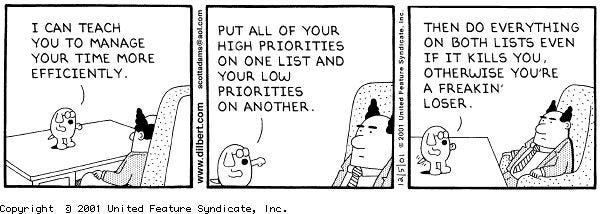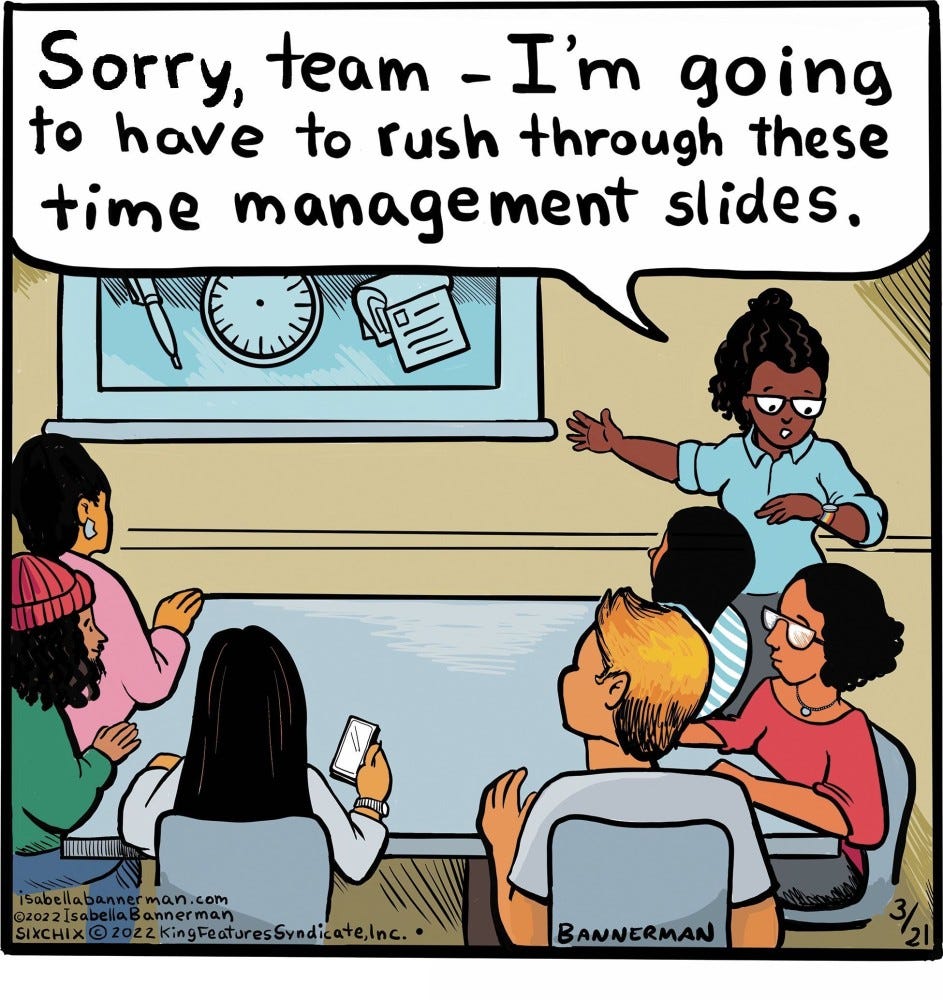From Hustle to Harmony: Mastering Energy for Peak Performance
“Time is free, but it’s priceless. You can’t own it, but you can use it. You can’t keep it, but you can spend it. Once you’ve lost it you can never get it back.” Harvey Mackay
We believe managing time is the cornerstone of productivity. But if that's true, why do those with endless hours still struggle to get things done while others with jam-packed schedules accomplish so much?
Picture this: a day where your energy levels are perfectly aligned with your tasks, where you meet each meeting, project, and challenge with enthusiasm and clarity. This isn’t a fantasy but a reality embraced by the most successful innovators of our time. They understand that productivity isn’t about squeezing every second out of your day but harnessing and optimizing your energy.
Take Oprah Winfrey & Tim Ferriss, for instance. Oprah, the media mogul and philanthropist, knows the value of self-care and taking time to recharge. She champions practices like meditation and adequate sleep as essential for sustaining energy and maintaining peak performance. Tim Ferriss, the author of "The 4-Hour Workweek" and renowned podcaster, advocates for batching tasks and setting aside blocks of uninterrupted time for deep work. By understanding their energy patterns and structuring their days accordingly, they’ve achieved extraordinary success without burning out.
Moreover, experts like Jim Loehr, Michael Watkins, and Gretchen Rubin offer invaluable insights into energy management. Jim Loehr emphasizes the importance of regular breaks and staying active to boost energy levels. Michael Watkins encourages prioritizing tasks and dedicating time for deep work. Gretchen Rubin believes in identifying your energy type to tailor strategies that maximize productivity.
The secret sauce to skyrocketing your productivity lies in mastering energy management, unique to you, not just time management. By recognizing the ebb and flow of your energy levels throughout the day and aligning your tasks accordingly, you can transform the way you work. It’s time to shift your focus from the relentless pursuit of managing time to harnessing your energy for a more fulfilling and successful life.
Rethinking Productivity: From Time Management to Energy Optimization
Two decades ago, when I moved from Britain to Spain, I didn't just cross borders; I stepped into a whole new world where time had a different rhythm. In Britain, time was a strict taskmaster, but in Spain, it danced to a more relaxed beat. This profound cultural shift went beyond language and customs, challenging everything I thought I knew about productivity. Enter American anthropologist Edward T. Hall (1), whose concept of 'monochronic' and 'polychronic' cultures unlocked a new perspective for me: thriving in my new home wasn’t just about managing time but about managing energy. This framework became essential for understanding the diverse perspectives on time management and productivity.
In Britain’s monochronic culture, time is linear, sliced into neat segments. People focus on one task at a time, prizing punctuality, schedules, and efficiency. This approach, the bedrock of hustle culture, emphasizes order and control. I was used to this structured rhythm where every minute was accounted for, and productivity was measured by how well one adhered to the clock.
However, in Spain’s polychronic society, time is fluid, similar to life in the Blue Zones - places where people live long, healthy lives through balanced, low-stress living. Relationships and experiences take precedence over strict schedules. People juggle multiple tasks simultaneously, prioritizing flexibility, adaptability, and connection. This cultural shift was a shock but challenged me to rethink my productivity strategies. I needed to align my energy levels with my tasks rather than rigidly sticking to the clock.
Understanding these distinct cultural orientations towards time is crucial for bridging differences in productivity attitudes. We can embrace alternative approaches that prioritize energy management by acknowledging the limitations of a monochronic-centric view.
Over the years, I discovered that shifting from strict time management to energy management can significantly enrich both personal and professional lives. By understanding and respecting the fluidity of polychronic time, I found a balance that allowed for productivity and meaningful experiences. This holistic approach to time and energy has not only improved my efficiency but also enhanced my overall well-being.
The Fallacy of Time Management
In today's fast-paced world, hustle culture has become a phenomenon that glorifies long work hours, constant availability, and the relentless chase for success, often at the expense of personal well-being. Many executives come to me with this mindset, driven by the belief that more time spent working equals greater accomplishments can lead to severe consequences, including burnout.
Time management strategies typically encourage individuals to pack their schedules with tasks, leaving minimal room for downtime or self-care. The underlying message is clear: every moment not spent being productive is seen as a missed opportunity. This constant pressure to perform creates a never-ending cycle of stress and anxiety that can take a heavy toll on mental and physical health.

One business professional found themselves unintentionally stretching out their workday through procrastination, believing that ‘doing’ more would lead to greater accomplishments. However, this approach left them dissatisfied because they needed to set deadlines to avoid distractions. By intentionally adding joy and prioritizing self-care—scheduling it and ensuring it happened daily—they discovered a boost in their productivity.
Hustle culture promotes the idea that sacrificing personal well-being is a necessary trade-off for success. Sleep deprivation, skipped meals, and neglected social connections become badges of honor, indicating dedication to work. Unfortunately, this mindset often results in diminished creativity, reduced productivity, and compromised overall well-being. Traditional time management can inadvertently fuel a toxic cycle of overwork and burnout by perpetuating the misconception that constant hustle is the key to success.
One prominent figure who has spoken extensively about the pitfalls of hustle culture and the importance of prioritizing well-being is Arianna Huffington, co-founder and former editor-in-chief of The Huffington Post.
In her book "The Sleep Revolution,” Huffington discusses her personal wake-up call when she collapsed from exhaustion and broke her cheekbone, leading her to reevaluate her relationship with work and success. She advocates for the importance of sleep, meditation, and self-care in achieving sustainable success, challenging the notion that accomplishment necessitates sacrificing well-being.
In an interview with CNBC, Huffington stated,
"We need to redefine what we consider success, so it’s not just about the two metrics of money and power, but includes a third metric—well-being, our health, our ability to experience joy, our ability to find meaning in our lives."
By sharing her personal experiences and insights, Arianna Huffington serves as a powerful example of someone who recognized the limitations of traditional time management and the dangers of hustle culture, ultimately embracing a more holistic approach to success and productivity.
Dispelling the Misconception: More Time Doesn't Equal Higher Productivity
A study conducted by Stanford University (2) found that productivity declines sharply when individuals work more than 50 hours per week. Surprisingly, those working 70 hours achieved the same output as those working 55 hours. This finding suggests there are diminishing returns when we invest excessive time in work without considering other factors such as energy levels and focus.
Prolonged exposure to stress impairs cognitive functions such as memory, focus, and decision-making, essential for productivity. A study published in the Journal of Occupational Health Psychology (3) found that long work hours and the resulting stress decreased performance, particularly in complex tasks requiring higher-level cognitive abilities.
The fallacy of equating time spent with productivity becomes even more evident when considering the concept of "deliberate practice," popularized by Anders Ericsson (4), a Swedish psychologist. Deliberate practice emphasizes the quality of focused and goal-oriented practice over the sheer quantity of time spent. This approach highlights the importance of rest, reflection, and feedback in enhancing performance instead of just investing more hours.
Learning to Work Smarter: Choosing Tasks Wisely
Imagine transforming the way you work by making conscious choices about which tasks to tackle based on the energy they return. Prioritizing tasks that boost your energy and fulfillment while minimizing those that drain you can revolutionize your productivity. Here’s how to master intentional task selection and elevate your performance.
High-Energy Strategies
Strategic Time Units
Divide your day into strategic time units, allocating specific blocks for tasks requiring different energy levels, creativity, and focus. You ensure optimal performance throughout the day by matching tasks with your energy peaks.
Intentional Task Selection
Choosing tasks wisely means investing your energy where it counts. Prioritize high-return tasks to maximize productivity and enhance satisfaction. Minimize time on low-return tasks to save energy for more meaningful activities.
Evaluating Task Returns
Assess tasks based on personal satisfaction, growth, and goal achievement. High-return tasks align with your values, offer learning opportunities, and significantly contribute to long-term objectives. Medium-return tasks are necessary for daily operations but offer fewer growth opportunities. Delegate where possible low-return tasks to conserve energy for more rewarding activities, as they contribute minimally to satisfaction and goals.
Align Tasks with Personal Values
Choose tasks that resonate with your values and goals. Engaging in meaningful work can energize and motivate you, increasing productivity and satisfaction.
Low-Energy Strategies
Break Tasks into Manageable Steps
Divide larger tasks into smaller, manageable steps to prevent feeling overwhelmed and boost a sense of accomplishment. Short deadlines for each step can create momentum and keep you motivated.
Utilize the Eisenhower Matrix
Categorize tasks based on importance and urgency using the Eisenhower Matrix, a simple yet powerful tool that helps you prioritize by dividing tasks into four quadrants: urgent and important, important but not urgent, urgent but not important, and neither urgent nor important. Focus on tasks that are both important and energizing. Some executives find it helpful to cluster similar tasks, like completing all admin work before deep work, to prevent mental clutter. Others find it useful to remember why you are doing each task. Ask yourself what higher goal or purpose does each serve? Take a minute to notice what comes up for you as you answer that.
Delegate Non-Essential Tasks
Delegate tasks that don’t align with your strengths or personal values, freeing uptime and energy for high-priority activities.
Incorporate Breaks and Self-Care
Regular breaks and self-care are essential for maintaining energy levels. Prioritize physical and mental well-being to sustain motivation and productivity.
Main Takeaways
Energy Management Over Time Management: Shift your focus from squeezing every second out of your day to optimizing your energy levels. Recognize that productivity isn't about working more hours but about working smarter and aligning tasks with your energy peaks.
Strategic Task Selection: Prioritize high-return tasks that align with your values and contribute significantly to your long-term goals. Minimize or delegate low-return tasks to conserve your energy for more meaningful activities.
Utilize Strategic Time Units: Break your day into specific blocks for tasks that require different levels of energy, creativity, and focus. This ensures you’re always working at your best, matching the right tasks with the right times.
Incorporate Self-Care and Breaks: Regular breaks and self-care activities are essential for maintaining high energy levels. Prioritize your physical and mental well-being to sustain motivation and productivity throughout the day.
Leverage the Eisenhower Matrix: Categorize tasks based on importance and urgency to focus on what truly matters. Group similar tasks to prevent mental clutter and maintain a clear, focused mind.
Embrace a Holistic Approach: Understand that both high-energy and low-energy tasks play a role in your productivity. Break larger tasks into manageable steps, and set short deadlines to create momentum and keep yourself motivated.
By adopting these strategies, you can achieve a balanced, productive life, reaching your goals without sacrificing your well-being. It’s time to redefine success—not by the hours you log, but by the energy and passion you bring to your work.
Take the Quiz: Discover Your Productivity Style!
Ready to uncover your unique productivity style? Are you a laid-back Blue Zone enthusiast or a driven Hustler? Find out how you can optimize your energy levels for maximum productivity and well-being. Take our fun and insightful Productivity Temperament Quiz now and discover how you can harness your energy for a more fulfilling life!
Get ready to transform your approach to productivity and unlock the secret to thriving in your own rhythm!
(1) Hall, E. T. (1959). The silent language. Doubleday.
(2) Pencavel, J. H. (2014). The productivity of working hours. Institute for the Study of Labor (IZA).
(3) Regehr, M. L., Hemphill, A. K., Pompe, B. G. W., Zapf, M. G., Beck, J., & Litz, J. K. (2018). Effects of job stressors on task performance in emergency medicine. Journal of Occupational Health Psychology, 23(4), 514–527. https://doi.org/10.1037/ocp0000105
(4) Ericsson, K. A., Krampe, R. T., & Tesch-Römer, C. (1993). The role of deliberate practice in the acquisition of expert performance. Psychological Review, 100(3), 363–406. https://doi.org/10.1037/0033-295X.100.3.363











